H2 Production from Catalytic Methane Decomposition Using Fe/x-ZrO2 and Fe-Ni/(x-ZrO2) (x = 0, La2O3, WO3) Catalysts
Abstract
1. Introduction
2. Results and Discussion
2.1. Characterization of Catalysts
2.1.1. X-ray Diffraction (XRD)
2.1.2. Textural Properties
2.1.3. Temperature-Programmed Reduction (TPR)
2.2. Catalytic Test
2.3. Characterization of Spent Catalysts and Carbon Produced
2.3.1. Thermo-Gravimetric Analysis (TGA)
2.3.2. Raman Spectroscopy Analysis
3. Materials and Methods
3.1. Materials
3.2. Catalyst Preparation
3.3. Catalyst Activity
3.4. Catalyst Characterization
4. Conclusions
Author Contributions
Funding
Acknowledgments
Conflicts of Interest
References
- Heiserman, D.L. Exploring Chemical Elements and Their Compounds; Tab Books: New York, NY, USA, 1992; ISBN 9780830630158. [Google Scholar]
- Suess, H.E.; Urey, H.C. Abundances of the elements. Rev. Mod. Phys. 1956, 28, 53–74. [Google Scholar] [CrossRef]
- Seeds, M.A. Horizons: Exploring the Universe; Brooks Cole: Pacific Grove, CA, USA, 2016; ISBN 1305957377. [Google Scholar]
- Hetland, J.; Mulder, G. In search of a sustainable hydrogen economy: How a large-scale transition to hydrogen may affect the primary energy demand and greenhouse gas emissions. Int. J. Hydrog. Energy 2007, 32, 736–747. [Google Scholar] [CrossRef]
- Kang, D.; Lee, J.W. Enhanced methane decomposition over nickel–carbon–B2O3 core–shell catalysts derived from carbon dioxide. Appl. Catal. B Environ. 2016, 186, 41–55. [Google Scholar] [CrossRef]
- Zhou, L.; Guo, Y.; Hideo, K. Unsupported nickel catalysts for methane catalytic decomposition into pure hydrogen. AIChE J. 2014, 60, 2907–2917. [Google Scholar] [CrossRef]
- Nakagawa, K.; Nishitanigamo, M.; Ando, T. Hydrogen production from methane for fuel cell using oxidized diamond-supported catalysts. Int. J. Hydrog. Energy 2005, 30, 201–207. [Google Scholar] [CrossRef]
- Rodriguez, N. A review of catalytically grown carbon nanofibers. J. Mater. Res. 1993, 8, 3233–3250. [Google Scholar] [CrossRef]
- Li, Y.; Zhang, B.; Xie, X.; Liu, J.; Xu, Y.; Shen, W. Novel Ni catalysts for methane decomposition to hydrogen and carbon nanofibers. J. Catal. 2006, 238, 412–424. [Google Scholar] [CrossRef]
- Abbas, H.F.; Daud, W.W. Thermocatalytic decomposition of methane for hydrogen production using activated carbon catalyst: Regeneration and characterization studies. Int. J. Hydrog. Energy 2009, 34, 8034–8045. [Google Scholar] [CrossRef]
- Li, J.; Smith, K.J. Methane decomposition and catalyst regeneration in a cyclic mode over supported Co and Ni catalysts. Appl. Catal. A Gen. 2008, 349, 116–124. [Google Scholar] [CrossRef]
- Ashik, U.; Abbas, H.F.; Abnisa, F.; Kudo, S.; Hayashi, J.-I.; Daud, W.M.A.W. Methane decomposition with a minimal catalyst: An optimization study with response surface methodology over Ni/SiO2 nanocatalyst. Int. J. Hydrog. Energy 2020, 45, 14383–14395. [Google Scholar] [CrossRef]
- Takenaka, S.; Shigeta, Y.; Tanabe, E.; Otsuka, K. Methane decomposition into hydrogen and carbon nanofibers over supported Pd−Ni catalysts: Characterization of the catalysts during the reaction. J. Phys. Chem. B 2004, 108, 7656–7664. [Google Scholar] [CrossRef]
- Bayat, N.; Rezaei, M.; Meshkani, F. Hydrogen and carbon nanofibers synthesis by methane decomposition over Ni–Pd/Al2O3 catalyst. Int. J. Hydrog. Energy 2016, 41, 5494–5503. [Google Scholar] [CrossRef]
- Escobar, C.; Perez-Lopez, O.W. Hydrogen production by methane decomposition over Cu–Co–Al mixed oxides activated under reaction conditions. Catal. Lett. 2014, 144, 796–804. [Google Scholar] [CrossRef]
- Bayat, N.; Rezaei, M.; Meshkani, F. Methane decomposition over Ni–Fe/Al2O3 catalysts for production of COx-free hydrogen and carbon nanofiber. Int. J. Hydrog. Energy 2016, 41, 1574–1584. [Google Scholar] [CrossRef]
- Torres, D.; Pinilla, J.; Suelves, I. Co-, Cu- and Fe-doped Ni/Al2O3 catalysts for the catalytic decomposition of methane into hydrogen and carbon nanofibers. Catalysts 2018, 8, 300. [Google Scholar] [CrossRef]
- Kabe, T.; Qian, W.; Funato, A.; Okoshi, Y.; Ishihara, A. Hydrodesulfurization and hydrogenation on alumina-supported tungsten and nickel-promoted tungsten catalysts. Phys. Chem. Chem. Phys. 1999, 1, 921–927. [Google Scholar] [CrossRef]
- Rezgui, Y.; Guemini, M. Effect of acidity and metal content on the activity and product selectivity for n-decane hydroisomerization and hydrocracking over nickel–tungsten supported on silica–alumina catalysts. Appl. Catal. A Gen. 2005, 282, 45–53. [Google Scholar] [CrossRef]
- Baertsch, C.D.; Komala, K.T.; Chua, Y.-H.; Iglesia, E. Genesis of brønsted acid sites during dehydration of 2-butanol on tungsten oxide catalysts. J. Catal. 2002, 205, 44–57. [Google Scholar] [CrossRef]
- Pudukudy, M.; Yaakob, Z.; Shan, S.; Takriff, M.S. Catalytic decomposition of methane over rare earth metal (Ce and La) oxides supported iron catalysts. Appl. Surf. Sci. 2019, 467–468, 236–248. [Google Scholar] [CrossRef]
- Al-Fatesh, A.S.; Kasim, S.O.; Ibrahim, A.A.; Al-Awadi, A.S.; Abasaeed, A.E.; Fakeeha, A.H.; Awadallah, A.E. Catalytic methane decomposition over ZrO2 supported iron catalysts: Effect of WO3 and La2O3 addition on catalytic activity and stability. Renew. Energy 2020, 155, 969–978. [Google Scholar] [CrossRef]
- Titus, J.; Roussière, T.; Wasserschaff, G.; Schunk, S.; Milanov, A.; Schwab, E.; Wagner, G.; Oeckler, O.; Gläser, R. Dry reforming of methane with carbon dioxide over NiO–MgO–ZrO2. Catal. Today 2016, 270, 68–75. [Google Scholar] [CrossRef]
- Sing, K.S.W.; Everett, D.H.; Haul, R.A.W.; Moscou, L.; Pierotti, R.A.; Rouquerol, J.; Siemieniewska, T. Reporting physisorption data for gas/solid systems. In Handbook of Heterogeneous Catalysis; Wiley: Hoboken, NJ, USA, 2008; pp. 1217–1230. [Google Scholar]
- Fakeeha, A.; Ibrahim, A.A.; Aljuraywi, H.; Alqahtani, Y.; Alkhodair, A.; Alswaidan, S.; Abasaeed, A.E.; Kasim, S.O.; Mahmud, S.; Al-Fatesh, A.S. Hydrogen production by partial oxidation reforming of methane over Ni catalysts supported on high and low surface area alumina and zirconia. Processes 2020, 8, 499. [Google Scholar] [CrossRef]
- Zhang, M.; Zhang, J.; Zhang, X.; Zhou, Z.; Song, F.; Zhang, Q.; Tan, Y.; Han, Y. How the reflux treatment stabilizes the metastable structure of ZrO2 and improves the performance of Ni/ZrO2 catalyst for dry reforming of methane? Energy Convers. Manag. 2020, 216, 112950. [Google Scholar] [CrossRef]
- Zhang, J.; Xie, W.; Li, X.; Hao, Q.-Q.; Chen, H.; Ma, X. Methane decomposition over Ni/carbon catalysts prepared by selective gasification of coal char. Energy Convers. Manag. 2018, 177, 330–338. [Google Scholar] [CrossRef]
- Ashok, J.; Subrahmanyam, M.; Venugopal, A. Hydrotalcite structure derived Ni–Cu–Al catalysts for the production of H2 by CH4 decomposition. Int. J. Hydrog. Energy 2008, 33, 2704–2713. [Google Scholar] [CrossRef]
- Fakeeha, A.H.; Ibrahim, A.A.; Naeem, M.A.; Khan, W.U.; Abasaeed, A.E.; Alotaibi, R.L.; Al-Fatesh, A.S. Methane decomposition over Fe supported catalysts for hydrogen and nano carbon yield. Catal. Sustain. Energy 2015, 2, 71–82. [Google Scholar] [CrossRef]
- Fakeeha, A.H.; Ibrahim, A.A.; Khan, W.U.; Seshan, K.; Al Otaibi, R.L.; Al-Fatesh, A.S. Hydrogen production via catalytic methane decomposition over alumina supported iron catalyst. Arab. J. Chem. 2018, 11, 405–414. [Google Scholar] [CrossRef]
- Al-Fatesh, A.; Fakeeha, A.; Ibrahim, A.; Khan, W.; Atia, H.; Eckelt, R.; Seshan, K.; Chowdhury, B. Decomposition of methane over alumina supported Fe and Ni–Fe bimetallic catalyst: Effect of preparation procedure and calcination temperature. J. Saudi Chem. Soc. 2018, 22, 239–247. [Google Scholar] [CrossRef]
- Fakeeha, A.H.; Al-Fatesh, A.S.; Chowdhury, B.; Ibrahim, A.; Khan, W.U.; Hassan, S.; Sasudeen, K.; Abasaeed, A.E. Bi-metallic catalysts of mesoporous Al2O3 supported on Fe, Ni and Mn for methane decomposition: Effect of activation temperature. Chin. J. Chem. Eng. 2018, 26, 1904–1911. [Google Scholar] [CrossRef]
- Chesnokov, V.V.; Chichkan, A.S. Production of hydrogen by methane catalytic decomposition over Ni–Cu–Fe/Al2O3 catalyst. Int. J. Hydrog. Energy 2009, 34, 2979–2985. [Google Scholar] [CrossRef]
- Reshetenko, T.; Avdeeva, L.; Ushakov, V.; Moroz, E.; Shmakov, A.; Kriventsov, V.; Kochubey, D.; Pavlyukhin, Y.; Chuvilin, A.; Ismagilov, Z. Coprecipitated iron-containing catalysts (Fe-Al2O3, Fe-Co-Al2O3, Fe-Ni-Al2O3) for methane decomposition at moderate temperatures. Appl. Catal. A Gen. 2004, 270, 87–99. [Google Scholar] [CrossRef]
- Chen, J.; Ma, Q.; Rufford, T.E.; Li, Y.; Zhu, Z. Influence of calcination temperatures of Feitknecht compound precursor on the structure of Ni–Al2O3 catalyst and the corresponding catalytic activity in methane decomposition to hydrogen and carbon nanofibers. Appl. Catal. A Gen. 2009, 362, 1–7. [Google Scholar] [CrossRef]
- Dresselhaus, M.S.; Jorio, A.; Hofmann, M.; Dresselhaus, G.; Saito, R. Perspectives on carbon nanotubes and graphene Raman spectroscopy. Nano Lett. 2010, 10, 751–758. [Google Scholar] [CrossRef] [PubMed]
- Kameya, Y.; Hanamura, K. Kinetic and Raman spectroscopic study on catalytic characteristics of carbon blacks in methane decomposition. Chem. Eng. J. 2011, 173, 627–635. [Google Scholar] [CrossRef]
- Ivleva, N.P.; Messerer, A.; Yang, X.; Niessner, R.; Pöschl, U. Raman microspectroscopic analysis of changes in the chemical structure and reactivity of soot in a diesel exhaust aftertreatment model system. Environ. Sci. Technol. 2007, 41, 3702–3707. [Google Scholar] [CrossRef] [PubMed]
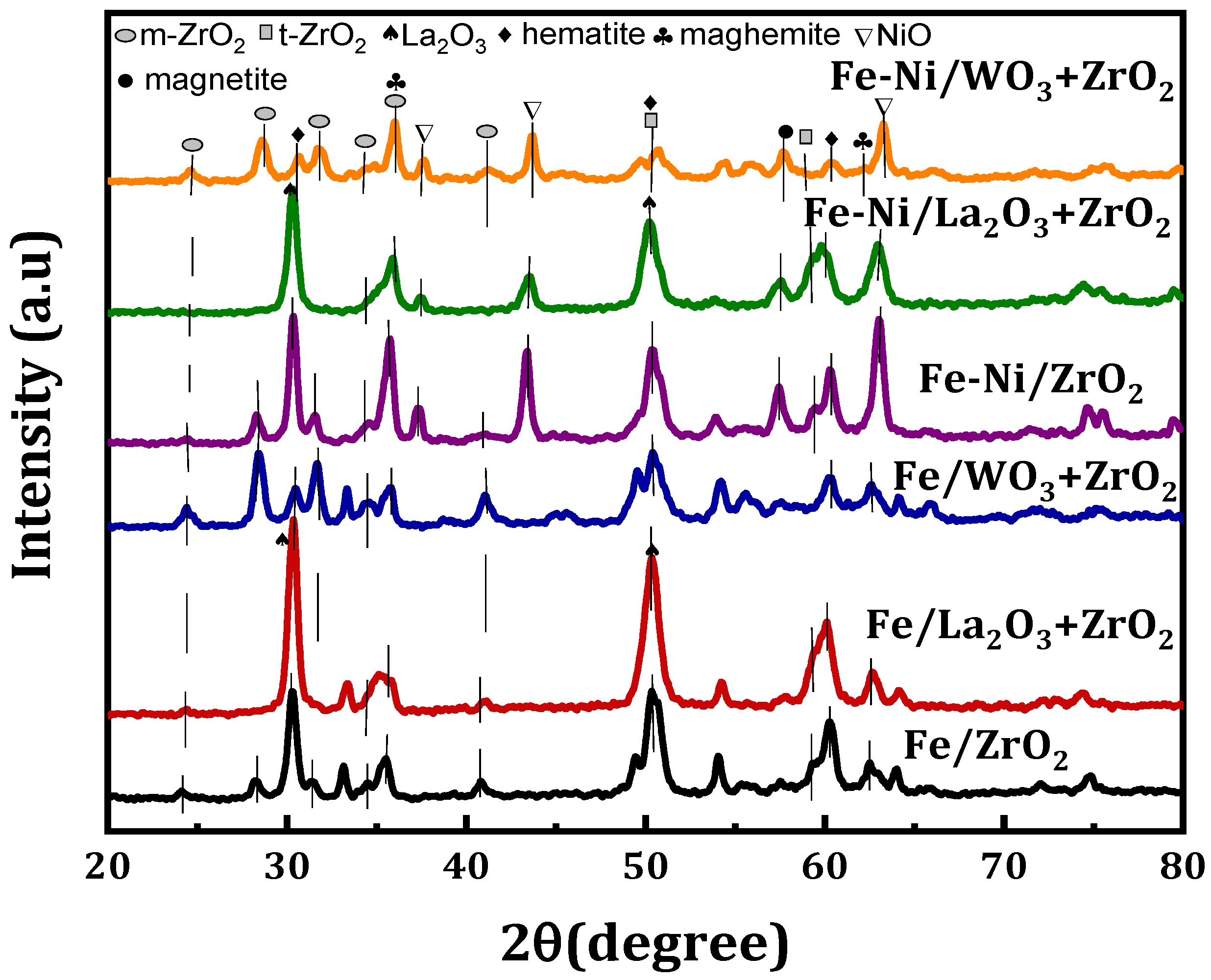
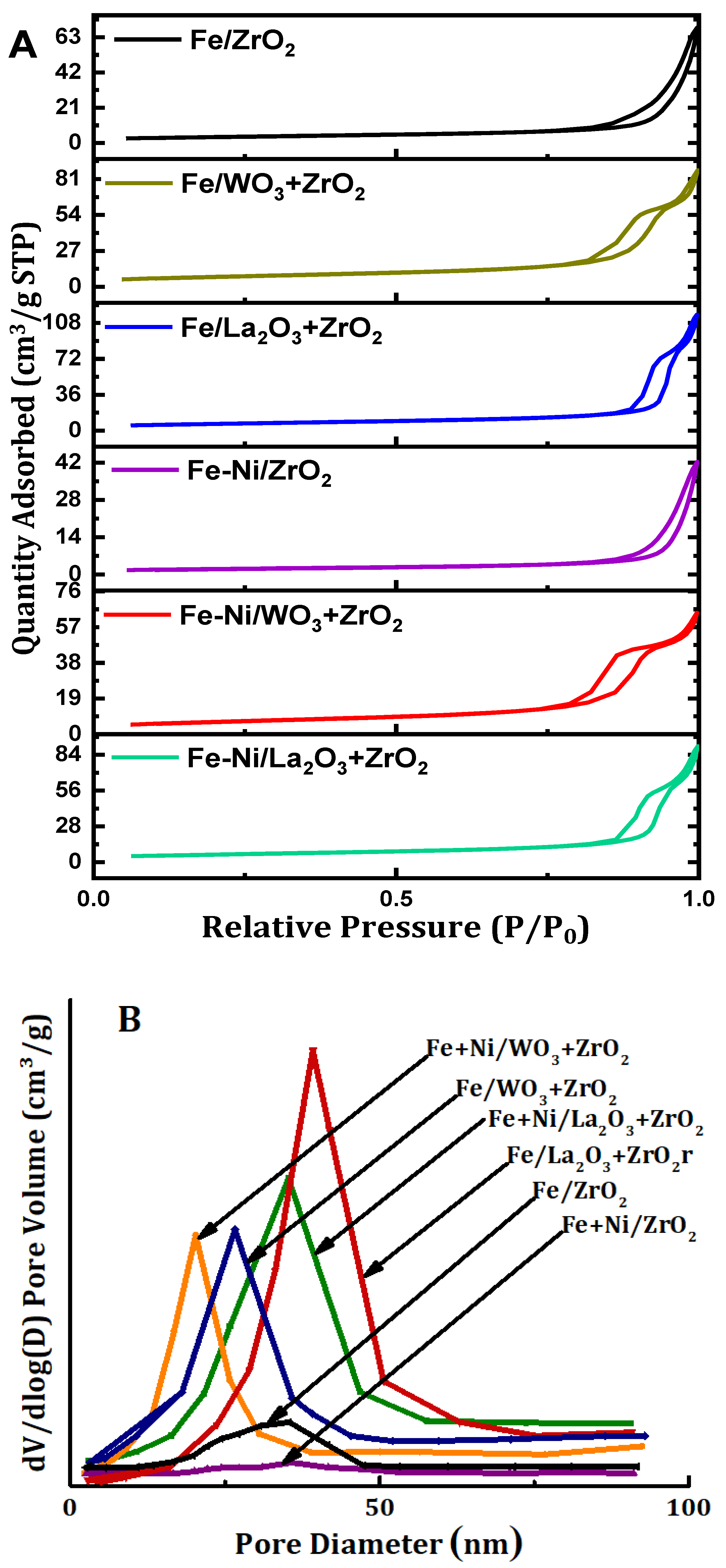
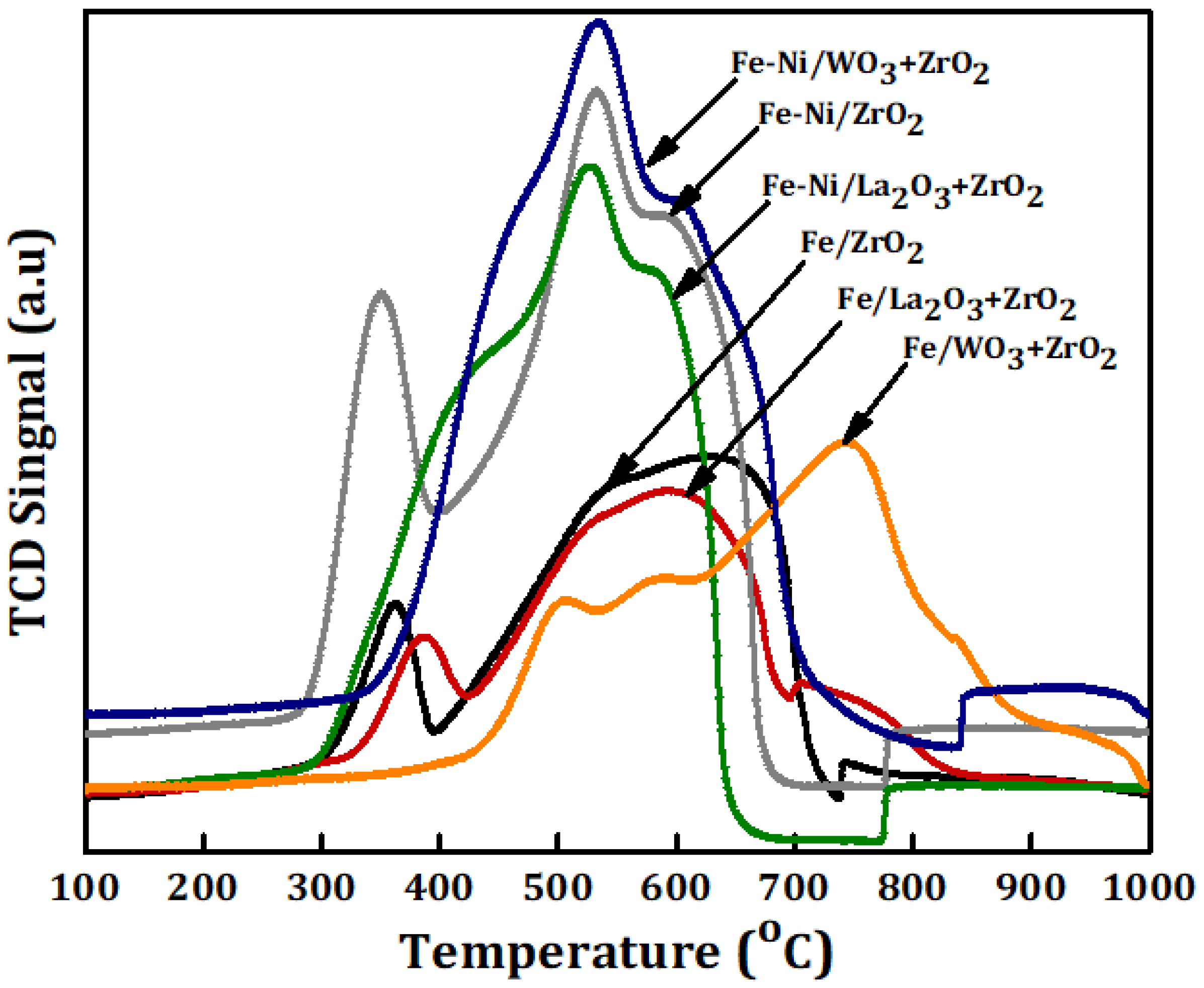
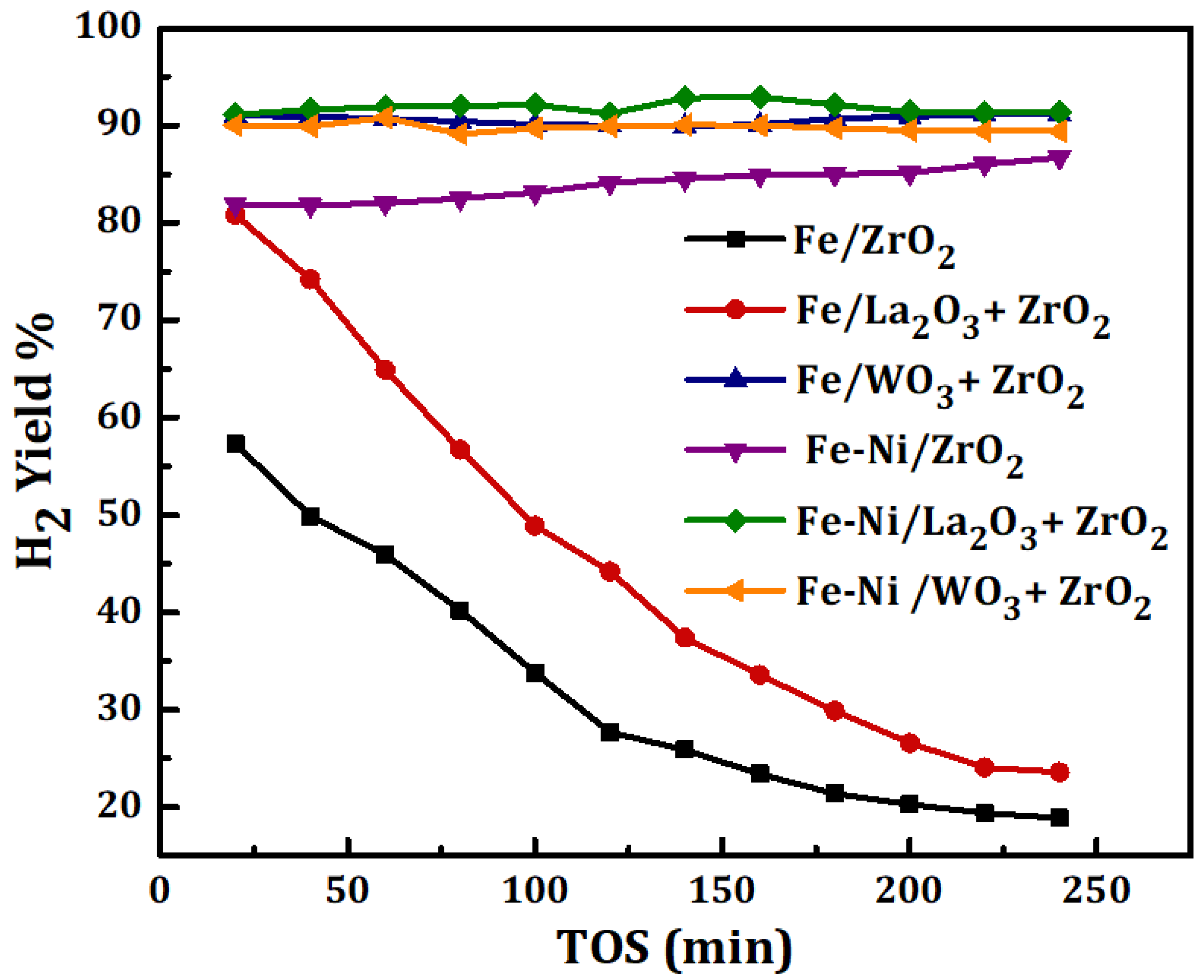
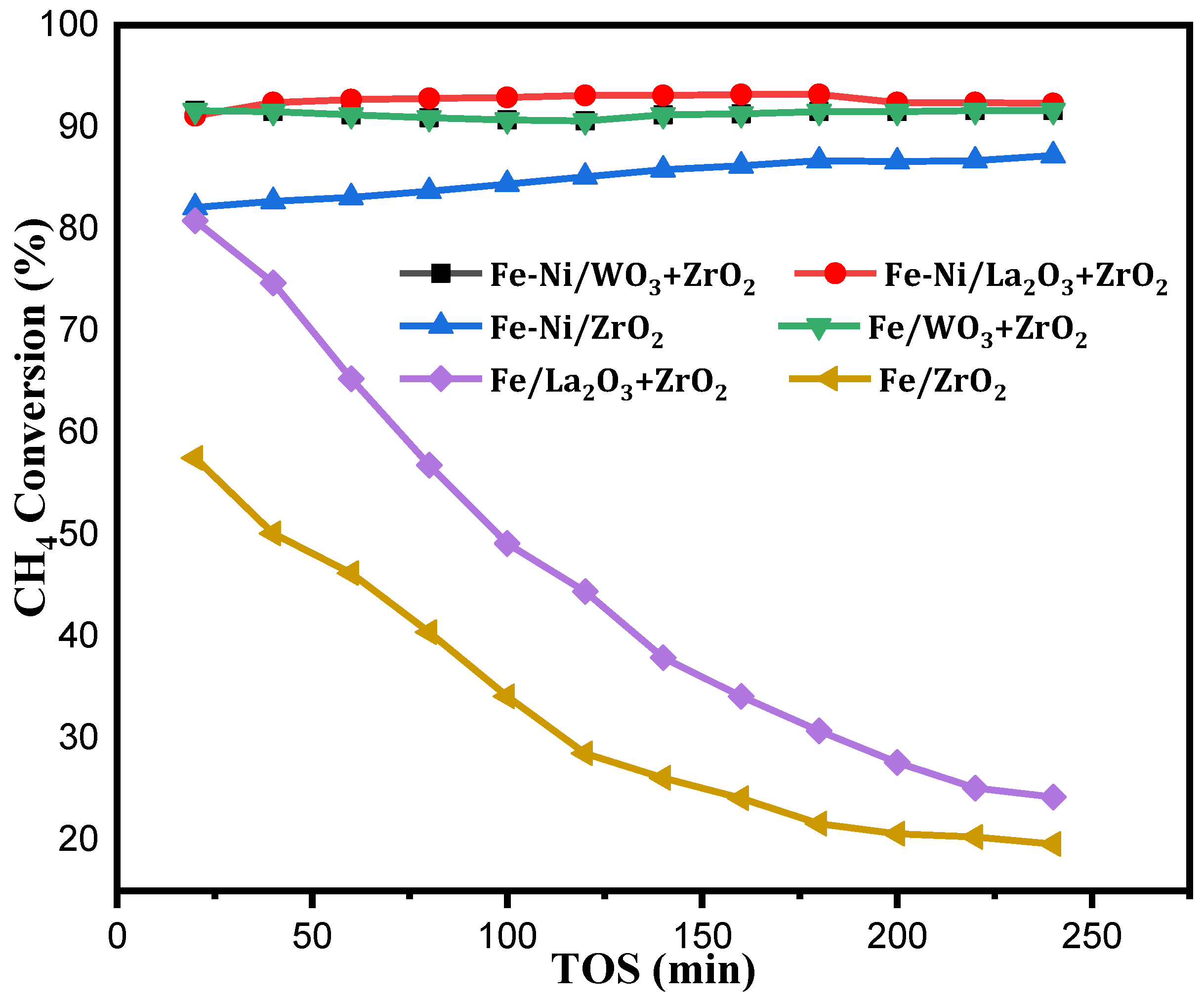


| Fresh Samples | ZrO2 | WO3 + ZrO2 | La2O3 + ZrO2 | Fe/ZrO2 | Fe/WO3 + ZrO2 | Fe/La2O3 + ZrO2 | Fe-Ni/ZrO2 | Fe-Ni/WO3 + ZrO2 | Fe-Ni/La2O3 + ZrO2 |
|---|---|---|---|---|---|---|---|---|---|
| BET surface area (m2/g) | 58.7 | 97.7 | 62.8 | 12.7 | 26.7 | 24.3 | 7.2 | 23.4 | 21.1 |
| Av. Pore diameter (nm) | 68.9 | 15.3 | 21.3 | 35.4 | 21.6 | 31.7 | 43.6 | 18.2 | 27.4 |
| Pore volume (cm3/g) | 0.3 | 0.3 | 0.3 | 0.1 | 0.1 | 0.2 | 0.1 | 0.0 | 0.1 |
| Catalyst | H2 Yield (%) | Mass of Catalyst (g) | Space Velocity (mLgcat−1 h−1) | Reaction Temperature (°C) | Reference |
|---|---|---|---|---|---|
| 30%Fe/MgO | 45 | 0.3 | 5000 | 700 | [29] |
| Fe/CeO2 | 66 | 2 | 4500 | 800 | [21] |
| Fe/La2O3 | 50 | 2 | 4500 | 800 | [21] |
| 20%Fe/Al2O3 | 80 | 0.3 | 5000 | 800 | [30] |
| 5%Ni-20%Fe/Al2O3 | 65 | 0.3 | 5000 | 700 | [31] |
| 15%Ni–30%/Fe/Al2O3 | 77 | 0.3 | 5000 | 700 | [32] |
| 70%Ni–10%Cu–10%Fe/Al2O3 | 77 | 1.5 | 2867 | 700 | [33] |
| 20%Fe/WO3 + ZrO2 | 90 | 0.3 | 4000 | 800 | Present work |
| Catalyst | Carbon Yield (g C/gcat) | Space Velocity (mLg−1 h−1) | Reaction Temperature (°C) | Reference |
|---|---|---|---|---|
| 30%Fe/MgO | 5.5 | 5000 | 700 | [29] |
| 70%Ni–10%Cu–10%Fe/Al2O3 | 8 | 2867 | 700 | [33] |
| 50Fe-6Co-Al2O3 | 41.0 | 45,000 | 675 | [34] |
| 62Fe-8Ni-Al2O3 | 122.0 | 45,000 | 675 | [34] |
| NiO–Al2O3 | 88 | 900,000 | 500 | [35] |
| 20%Fe/WO3 + ZrO2 | 0.58 | 4000 | 800 | Present work |
© 2020 by the authors. Licensee MDPI, Basel, Switzerland. This article is an open access article distributed under the terms and conditions of the Creative Commons Attribution (CC BY) license (http://creativecommons.org/licenses/by/4.0/).
Share and Cite
Al-Mubaddel, F.; Kasim, S.; Ibrahim, A.A.; Al-Awadi, A.S.; Fakeeha, A.H.; Al-Fatesh, A.S. H2 Production from Catalytic Methane Decomposition Using Fe/x-ZrO2 and Fe-Ni/(x-ZrO2) (x = 0, La2O3, WO3) Catalysts. Catalysts 2020, 10, 793. https://doi.org/10.3390/catal10070793
Al-Mubaddel F, Kasim S, Ibrahim AA, Al-Awadi AS, Fakeeha AH, Al-Fatesh AS. H2 Production from Catalytic Methane Decomposition Using Fe/x-ZrO2 and Fe-Ni/(x-ZrO2) (x = 0, La2O3, WO3) Catalysts. Catalysts. 2020; 10(7):793. https://doi.org/10.3390/catal10070793
Chicago/Turabian StyleAl-Mubaddel, Fahad, Samsudeen Kasim, Ahmed A. Ibrahim, Abdulrhman S. Al-Awadi, Anis H. Fakeeha, and Ahmed S. Al-Fatesh. 2020. "H2 Production from Catalytic Methane Decomposition Using Fe/x-ZrO2 and Fe-Ni/(x-ZrO2) (x = 0, La2O3, WO3) Catalysts" Catalysts 10, no. 7: 793. https://doi.org/10.3390/catal10070793
APA StyleAl-Mubaddel, F., Kasim, S., Ibrahim, A. A., Al-Awadi, A. S., Fakeeha, A. H., & Al-Fatesh, A. S. (2020). H2 Production from Catalytic Methane Decomposition Using Fe/x-ZrO2 and Fe-Ni/(x-ZrO2) (x = 0, La2O3, WO3) Catalysts. Catalysts, 10(7), 793. https://doi.org/10.3390/catal10070793







